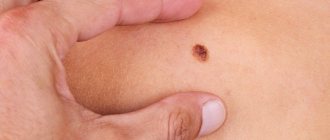Despite the fact that moles are benign neoplasms, sometimes it is necessary to remove them. They contain a large amount of melanin, so they have a darker color than the underlying skin. They can be large, small, and differ in location. The medical name is nevus. It is concentrated on any area of the skin and even mucous membranes. The more melanocytes accumulate in a mole, the brighter its color becomes. Formations are black, brown, burgundy, red, purple.
“Will you take a test from the mole the day before?”
The only analysis that can reliably determine the nature of the formation is histological examination. The formation is removed entirely and sent for pathomorphological examination. No “plucking” is performed in advance before removing moles.
It is possible to perform a cytological examination in advance if there is discharge, ulceration or trauma to the formation. This study allows you to establish a preliminary diagnosis and is performed when it is difficult to make a preliminary diagnosis. Often, an external examination or dermatoscopy is sufficient to make a diagnosis. For example, in relation to fibroepithelial polyps (papillomas), keratomas, fibromas, viral warts, a fairly large group of nevi (intradermal, warty, non-pigmented, etc.).
brief information
Depending on the thickening of the surface, moles are divided into 2 types
:
- convex;
- flat.
It is the first formations that are most dangerous, since they are often damaged and can therefore become deformed into a malignant composition. This is one of the reasons why a nevus needs to be removed. For this purpose, medications, traditional methods, physiotherapeutic procedures, and surgery are used. The operation is considered gentle, requiring only local application of an anesthetic. Therefore, the rehabilitation period after it lasts a limited time, complications rarely occur. You just need to take proper care of your skin to prevent infection or bruising.
“Should I remove moles or not?”
There are formations on the skin that need to be removed because there is a high risk of cancer.
Mostly such formations are excised with mandatory histological examination of the surgical material. Benign, non-precancerous skin formations must be removed for cosmetic reasons, in case of unpleasant sensations (trauma, itching), if permanent damage to the formation or other discomfort occurs.
In any case, you should consult a dermatologist or oncologist about whether moles need to be removed. He should also recommend the optimal removal method.
When removal is urgent
There is one rule for all moles - if they don't bother you, don't bother them. However, there are a number of indications for removal.
Injury
If a mole has been injured or abraded (for example, by a fall or clothing), it must be completely removed to avoid degeneration into melanoma.
After an injury occurs, stop the bleeding with a cotton swab containing hydrogen peroxide, and then apply a gauze bandage for 10-15 minutes. If the mole comes off completely, wrap it in a bandage soaked in saline solution and submit it for histological analysis. If damage occurs frequently, be sure to have the mole removed by a surgeon and be sent to a laboratory for analysis.
Interfering mole
In the case where the nevus is located where clothing constantly rubs against it (for example, a laundry strap), or in a folded area (such as the armpit), or in places where it can be easily torn off (hands, feet, neck), it is better delete it. It is also better to get rid of moles with “legs” - they can get twisted and are the easiest to tear off.
Suspicion of degeneration
If your mole changes in size, changes shape and color, or begins to peel, become inflamed or bleed, you need to get rid of it as soon as possible. Contact a dermatologist, or even better, immediately an oncologist, to rule out its malignant nature. If melanoma is removed in a timely manner, it almost never recurs, and recovery occurs in 95% of patients. In advanced cases, this is one of the most dangerous diseases.
Doctors often recommend removal of melanoma-dangerous moles—those that have a high probability of becoming a tumor.
In other cases, the issue of removal is decided individually, in consultation with an experienced doctor (dermatologist, surgeon, oncologist).
Ways to remove moles
- Surgical
All formations with minimal suspicion of malignancy are subject to excision within healthy tissue, with mandatory histological examination of the surgical material. Also, the surgical method is preferable for some large formations (more than 1.5 cm) from the point of view of the healing process and cosmetic effect.
- Minimally invasive: laser destruction, radio wave method
- Laser destruction
Most preferred for convex lesions, pedunculated lesions, seborrheic keratomas and warts, including large ones.
The advantage of the method is instant coagulation, without damage to adjacent tissues, without bleeding and instant formation of a crust on the wound. Laser destruction, unlike radioknife and electrocoagulation, does not conduct through the human body and is acceptable in patients with pacemakers and pacemakers.
During the laser destruction process, no ionizing radiation is generated and the impact is limited to the point of application, and is allowed in children and pregnant women. The method is practically non-contact, has a very high temperature at the point of application, and therefore eliminates the possibility of contracting infections such as HIV or hepatitis. The disadvantage of this method is that in most cases the removed material is not suitable for histological examination, so laser destruction is suitable for removing exclusively benign formations that do not raise doubts about the diagnosis.
- Radio wave method
It is a dissection of soft tissues in a non-traumatic manner using narrowly directed high-frequency radio waves, it allows you to make thin incisions with the adhesion of small vessels, sterilization of the surface - the high-frequency radio wave destroys microorganisms.
The method is suitable for removing small formations that require histological examination, since during removal the surgical material is minimally damaged or as an alternative to a scalpel when excising a formation. It has contraindications - pacemakers, epilepsy, glaucoma, diabetes, pregnancy, inflammatory processes in the acute stage.
Not suitable for removing “dry” formations - viral warts, formations with abundant keratosis.
Classification and characteristics
In total, approximately 60 types of formation have been identified, which are determined by dermatologists or oncologists. They are divided by appearance, size, shape, content and other parameters. Moles can be small, excessively large, up to 15 cm in diameter. If they are localized on the face, this leads to a severe cosmetic defect.
Classification by time of occurrence:
- congenital
- they are formed very rarely, have a small size, which makes them very difficult to see instantly; - acquired
- spread to the upper, deep, middle layers of the skin, between the dermis and epidermis.
The main types of nevi and their exact characteristics are presented in the table.
| Variety | Description |
| Nevus | Has a brown or black tint. Can be located in any area of the body. More common on the face |
| Blue nevus | Smooth, superficial, with a dense consistency. Their diameter is no more than 10 mm. The shade is dark brown or black. Localized singly on the body |
| Angioma | A network of capillaries and blood vessels grows in the epidermis. This leads to the formation of a benign tumor that remains under the skin |
| Lentigo | Presented on the body in the form of a brown or black pigment spot. Singularly located. Rarely found |
It is important to classify the mole before starting treatment so that mechanical impact does not lead to complications.
A liquid nitrogen
Effective methods for removing moles and papillomas include cryodestruction. The procedure uses liquid nitrogen, the temperature of which reaches -196 °C. This substance freezes the liquid in the altered cells, after which they are completely destroyed. The procedure is painless, so there is no need for anesthesia. After using liquid nitrogen, crusts may remain at the site of the growth. They are completely rejected after two weeks. As a rule, there are no scars at the site of removal of a mole or papilloma. Unfortunately, this method cannot be used if a tumor biopsy is required.
Laser Application
A dermatologist can offer the patient several ways to remove tumors. Naturally, the patient will give preference to the one that is the least traumatic and painless. Laser removal of papillomas and warts allows you to quickly get rid of the problem.
The microfractional beam evaporates the growth without affecting healthy tissue. To completely remove the tumor, one procedure is sufficient. There are no scars after using the laser. In addition, blood loss is also excluded.
- Diabetes.
- Blood diseases.
- Oncology.
- Pregnancy.
- Autoimmune diseases.
- Tendency to keloid scars.
- Epilepsy.
After the procedure, the wound heals within two weeks. Many patients who have chosen this method of treatment leave positive reviews on the Internet. The consequences of laser removal of papillomas and moles are clean and healthy skin. Just a few days after the procedure, the patient completely forgets about the eliminated growths. There are no side effects after using the laser.
Pharmacy preparations for freezing tumors
A doctor must remove moles. You cannot do this on your own. Otherwise, you can provoke a malignant degeneration of the nevus. You can remove papillomas yourself. Provided that the doctor has previously examined the patient and confirmed the diagnosis. And also approved the method of treatment. To do this, you can purchase a remedy for papillomas at the pharmacy, which freezes tumors. The most effective drugs include:
- "Wartner Cryo". Removes not only papillomas, but also warts. The active ingredient of the drug has a temperature of minus 40 degrees, this is quite enough to destroy the cells of the growth;
- "Veruklin". The mixture of gases of this drug has a temperature of minus 50 degrees. The papilloma completely dies off just two weeks after using this remedy;
- "Cryopharma". Contains propane and dimethyl ether. At the exit from the cylinder, their temperature reaches minus 57 degrees. One package is enough to treat 12 tumors. Within two weeks after the procedure, healthy skin is completely restored.
Prices for removing nevi on the nose
Removal of nevi (moles), fibroids in adults and children over 12 years of age
| Delete area | Size | Price, rub |
| Initial appointment with a cosmetologist, consultation free of charge - subject to completion of procedures on the day of application Make an appointment | 1000 0 | |
| Removal on the nose Make an appointment | up to 1 cm. | 2 500 |
| Removal on the nose Make an appointment | more than 1 cm. | 3 000 |
What moles on the face “say”
Since the time of the Inquisition, moles, age spots or birthmarks on a person’s body or face have been interpreted as symbolic. In this case (during the period of the Inquisition) they were regarded as marks of the devil or mystical signs, especially regarding formations on the face or hands. It was believed that Satan himself thus marks those whom he has chosen for his service. Most often, women suffered from this: if there was a mole on her body, and even more so, its location was on her face, then the woman most likely ended up in an Inquisition trial, where her guilt was determined, and the trial was followed by burning at the stake.
But already in the 18th century, the idea of moles and people with moles changed dramatically. This was due to the legend that existed at that time that the face of the goddess of love and beauty Venus was decorated with a mole. Therefore, a mole, and even on the face, was considered a sign of the patronage of Venus, and women of different classes and ages introduced the fashion for so-called flies, usually moles drawn above the lip (as it was believed - for good luck).
Recommended articles on the topic:
- Painless lip modeling: techniques and recommendations
- Beauty injections: types, preparations, reviews
- Eyelash restoration at home and in a beauty salon
Today, when many signs and prevailing opinions are a thing of the past, attitudes towards moles have been revised again. In the modern world, many people are indifferent to them, although various fortune tellers also endow them with sacred meaning and try to determine fate by the moles a person has. There are many articles that describe the meaning of moles based on their location on the body. However, there is no unambiguous assessment of this theory: there are those who unconditionally believe in it, and those to whom this whole version seems unrealistic, illogical and absurd.
We will still try to correlate a person’s moles with his possible fate and future.
There are different approaches to examining moles on the human body and face. One of the most popular is to look at the shape of the mole and its size. It is believed that if a mole is round in shape, it will bring goodness to its owner. A more elongated and oblong mole is a sign of good luck, but a sharp mole symbolizes the uncertainty of life.
If a mole is on the face, namely on the left eyebrow, this may indicate a late marriage, while a mole on the right eyebrow, on the contrary, means an early marriage.
If a mole is located in the area of the lips or directly on the lip, then it is believed that its owner will be endowed with great love, real feelings and generally marked with the sign of Venus, but at the same time, the character of such a person may be distinguished by hypocrisy, some superficiality or frivolity, and also fear loneliness. The same mole can have another interpretation - it can distinguish a person who is cheerful, kind and open to the world.
As soon as you have a mole on your right cheek, stormy love experiences will soon begin in your life, and if on your left, then you will probably soon encounter troubles and troubles.
A mole on the nose symbolizes success in everything and is considered a sign of incredible luck.
A mole located in the corner of the eye is found in a person with a calm and measured character.
We can conclude that the face is the place on which a mole is always a symbol or sign of some qualities or signs. And if you are planning to remove a mole, then you should first look at what it symbolizes. Perhaps this is a mole of total luck, wealth and prosperity, or the best health, and it is no coincidence that it appeared on your body.
Read material on the topic: Laser facial skin rejuvenation: useful tips and recommendations
What are moles? What are they?
To answer this question, you must first clarify what we mean by the word “mole.” An ordinary person can easily find several types of skin formations. Brown, red, flesh-colored - all these can be called moles. In fact, the World Health Organization (WHO) classification of benign skin lesions includes about 150 names. And all this diversity can also be called moles. Read a little more about the most common types of moles here.
As we said above, there are a huge number of types of moles. Today we will talk about those that are most common and, theoretically, can pose the greatest danger - brown and flesh-colored moles.
Electrocoagulation
High-frequency current is often used to combat tumors. This method of removing moles and papillomas is quite painful, so the doctor must use anesthesia. During the procedure, the doctor brings a special needle to the head of the growth, which conducts an electric current. A spark occurs between the device and the skin. It burns the neoplasm cells to the very foundation. There is no blister after the procedure. But a scar forms on the surface of the skin, which resolves over time.










